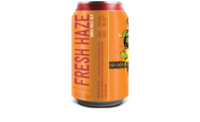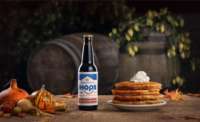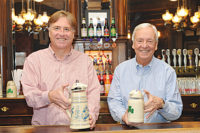Over the past 25 years, it’s been quite a journey to build New Glarus Brewing Co. into a successful craft brewery that annually brews 250,000 barrels of such iconic beers as Spotted Cow, Moon Man and Two Women from two brewery locations in the tiny town of New Glarus, Wis. (population 2,000). But that’s exactly what New Glarus Founder and President Deb Carey did with the help of her talented brewmaster husband, Daniel Carey, a Diploma Master Brewer.
When the couple was first starting out, Deb Carey was busy caring for their two young daughters, Nicole and Katherine, and working as an entrepreneur importing German furniture. A production supervisor at Anheuser Bush at the time, Daniel Carey was growing tired of the corporate environment and rotating shifts.
“We weren’t corporate people and we didn’t enjoy the lifestyle that went along with the job, so I said, ‘How about I start a brewery and you come work for me?,’” Deb Carey recalls. She went on to become one of the first women to own and operate a brewery in the United States.
“Today, I do everything but brew the beer. The whole reason I started the brewery is because my husband is an extremely talented brewmaster. I always joke that he has yeast in his veins,” Deb Carey says. “It’s his passion that drives us and he’s always doing research to develop new beers. He’s the driving force behind our variety of beers, and was the first person outside of Belgium to sour beers.
“We’re all about brewing world-class beers for our friends here in Wisconsin and taking care of the people who make it, and that’s the beginning and end of it,” she continues. “I often get asked if we do events and if people can bring food to the brewery. I tell them ‘No’ because I want them to go into town to eat and drink there.”
A local advantage
While many craft breweries seek to expand state-by-state until they achieve national distribution, New Glarus Brewing Co. took a decidedly different tact: brewing, bottling and distributing solely in the state of Wisconsin.
“Ninety-seven percent of places in Wisconsin that have a license sell at least one New Glarus product,” Deb Carey says. She notes that 40 percent of the company’s beer is sold in draft, in quarter barrels and half barrels, to bars and restaurants.
“Selling so much beer on draft is unusual, but it’s a big part of our success,” she says. “This goes back to the idea of listening to our customers and retailers.”
To drive tourism and help boost the local economy, the brewery bestows each visitor — some 250,000 to 300,000 annually — with a two-sided token containing the brewery’s iconic Wisconsin-inspired thumbprint logo on one side and a “good for one small tap beer on us” on the flip side.
“On the weekends, all the parking lots are full. A slow weekend is a couple of thousand people, a busy weekend is 12,000, so it’s like a festival every weekend,” she enthuses.
Nestled in the rolling hills of Southwestern Wisconsin about 30 miles from the Illinois border in an area known as “Little Switzerland,” New Glarus Brewing Co. was founded in 1993 with its original startup brewery: the 10,000-square-foot Riverside Brewery that underwent three expansions before it reached capacity; and Hilltop Brewery, a $20 million facility founded in 2007.
The 100-acre base of operation includes self-guided brewery tours of the sustainable, energy-efficient brewery, a spacious beer garden, tasting room, gift shop, beer depot and hiking trail along with a hop garden and an apple orchard growing Heritage apples for the brewery’s popular fruit-inspired beers.
Hilltop’s spacious grounds also are home to an effluent brewery treatment system, which is being expanded as part of a $2 million energy-savings program that reclaims wastewater for drinking-water usage in the town, Deb Carey says, proudly noting that daughter, Katherine, is overseeing the project as the brewery’s architect and project manager.
Separated by one mile, the two breweries maintain different brewing and packaging capabilities. For instance, Hilltop and Riverside operate bottling lines that run at speeds of 120 bottles a minute and 60 bottles a minute, respectively. Riverside features a small keg line, while Hilltop is home to a new canning line in which Spotted Cow, Moon Man and Totally Naked are being packaged in 12-packs of 12-ounce cans for the first time, hitting retailers’ shelves in July. Cans account for about 10 percent of the company’s packaging, Deb Carey says.
The breweries also differ in the types of beers being produced. The Riverside Brewery is where specialty craft beers are made, including the sours and barrel-aged beers. It also is home to a wild fruit cave where more esoteric, wild beers are produced. These beers are spontaneously fermented, Daniel Carey says.
Riverside also is home to a 100-barrel coolship, one of the largest open-top fermentation vessels of its kind in the United States, Daniel Carey says. Today, only a handful of U.S. breweries are using coolships, which began disappearing around 1960 when newer technology began replacing it.
“The wort that is produced stays overnight in the coolship and as it cools down, it becomes inoculated with the micoorganisms in the air and barrel,” he explains. “We make a brown beer and a blonde beer using this technology and from that, there are infinite possibilities.
“This is how beer was made in the old days,” he continues. “It’s like a pie pan that you leave on the windowsill overnight to cool. This is absolutely one of the best ways to make sour beers.”
“Drink Indigenous”
Given the Wisconsin-based roots of New Glarus Brewing, “Drink Indigenous,” meaning buy local, drink local, is an integral part of the company’s tag line and heritage.
The brewery is focused on using local products sourced from Wisconsin. For example, the aluminum cans are made in Jefferson; the packaging comes from Wausau; the labels are shipped from LaCrosse; and the bottles come from Berlin, Deb Carey says.
The husband-and-wife team note that the quality and flavor of New Glarus’ 20 SKUs, including sour porters, Belgium sours, pale ales, Abbey style ales and refreshing fruit-inspired beers, keep consumers on the look-out for the latest limited-edition release.
During the past 25 years, Daniel Carey estimates he’s crafted more than 200 beers, paying homage to the Old World European style of brewing as he seeks to seamlessly bend the art and science of beer-making.
“It’s really about exploring flavor,” he explains. “On one hand, people like new products and there’s a market for it. But I’m a foodie, and just like there’s many combinations of food flavors, there’s also many intriguing combinations of beer flavors.”
For example, Stone Soup is a sophisticated Abbey style ale that is cleanly aromatic with spicy notes of clove and ginger; Serendipity Happy Accident Fruit Ale is brewed with apples, cranberries and cherries; and the “nothing to hide” Totally Naked is a golden-colored lager with Noble hops imported from Germany and the Czech Republic.
Particularly in the summer months, demand for fruit-inspired beers is high. “The idea for Strawberry Rhubarb came from Deb. Strawberry rhubarb is a popular pie in Wisconsin, so Deb requested that we make a beer that tastes like one,” Daniel Carey says. “In the end, the beers are chosen by our customers. We have a wide variety of beers and some are more popular than others. We don’t have large advertising campaigns for our beers — we put it out there quietly so there’s more a pull than a push.”
The brewery also offers five year-round releases: the aforementioned Spotted Cow, a 5 percent alcohol-by-volume (ABV) farmhouse ale infused with four natural, hand-selected ingredients; Moon Man, a session pale ale with a bright bold blend of five hops; Two Women, a classic country lager brewed with Weyermann’s flavored malting; Raspberry Tart, a Wisconsin Framboise ale; and Belgian Red, which is brewed with whole Montmorency cherries, Wisconsin farmed wheat and Belgian roasted barleys before being aged at Riverside for one full year.
Spotted Cow is the top-selling SKU, but Two Women is catching up, Deb Carey says. “In fact, Two Women sales are up 80 percent. Moon Man is the best-selling IPA in the state by far, making up 30 percent of sales,” she adds.
A bold brew for 25 years
In honor of the brewery’s 25th anniversary, New Glarus is offering 500-ml bottles of its limited-edition 25th Anniversary Ale, an 11 percent ABV brew loosely designed like a Belgium-style quadruple. It is aged for six months in brandy barrels, Daniel Carey says.
“Brandy is popular in Wisconsin, so we used California brandy barrels instead of traditional bourbon barrels to age the beer and added some locally sourced maple syrup, strong dark maple syrup, to give it a unique twist,” the brewmaster says. “We used a blend of American, English and German malts and Australian hops and created a big, strong beer. It’s one of my favorites.”
When it comes to research and development, he notes that there are endless combinations depending on the different malts, hops and yeast used. “New Glarus always is testing ways to improve flavor stability over time. The biggest obstacle is that beer has a finite shelf life of three to six months, depending on the beer. Some beers, like our 25th Anniversary Ale might last for 20 years, but that’s rare.”
New Glarus’ quality, experimentation and the diversity of its craft beers sets it apart from the competition, the Carey’s say. Integrity also is important.
“It’s the quality of the beer, but I think I’ve also done an exceptional job branding our products in a way that has deep integrity that resonates with people,” Deb Carey explains. “I think integrity in business is rare and taking care of your people should be the first priority.”
In addition to providing health insurance and a 401K program, since 2015, New Glarus’ employees are part of the brewery’s employee stock ownership plan (ESOP). “You have to be profitable and responsible, but the big motivator for me is taking care of the people here,” she says. “Being employee owned isn’t easy, and I could have sold out for a lot of money, but the way I look at this brewery and America, is that we’re all in it together.”
The company’s motto, “From Barley to Bottle, True to Style Without Compromise Ever,” is found on all of its packaging and its signature logo, a thumbprint of the state of Wisconsin, is stamped in bright colors on all its bottle caps, depending on the beer style.
Initially, Deb Carey says she struggled to find a way to convey the handmade, handcrafted nature of New Glarus’ beers before driving inspiration from an unlikely source.
“My first idea was trying to make New Glarus into a hand,” the artist explains. “However, it turned out clunky so I didn’t use it. Then, while I was hiking, I was looking at a topographic map and thought it kind of looked like a thumbprint, so I combined a thumbprint and the outline of Wisconsin for the logo.”
Reflecting back on 25 years, the Carey’s marvel at how fast time has flown and at New Glarus’ success. In 2017, the brewery generated $64 million in sales and sales of around $67 million are likely this year, Deb Carey says.
“Our goal has always been to make handcrafted, world-class beer and things like production, money and goals have never really been important to us. We obviously wanted to be profitable so at the very least, we wanted to brew 5,000 or 8,000 barrels because that was break even.
”We were founded in 1993 and I think we hit 8,000 barrels by 1996,” she continues. “In regards to marketing and production, I did what most people do starting out. I took on more wholesalers until I could cover my state. I sent beer to Chicago because it’s like the third biggest market in America and it’s so close.”
While Deb Carey originally thought Chicago would be a big part of the brewery’s profit center, the opposite was true. “It was a nightmare,” she explains. “We had young children, had to get up early and people always wanted a deal and we couldn’t give them one. … At a certain point, I realized my best course of action was to reach customers directly. I started giving tours and because of that, I got a lot of insight into what people liked and what they were interested in.”
The first brewery, Riverside, was converted from an abandoned warehouse purchased from businessman Rudy Roehner, who became the Carey’s first investor.
“I traded some of my stock in the company to him for occupation for the land for a year, then we had an agreed upon price buyout,” Deb Carey explains. “I also traded up for the refrigeration, negotiated a loan with no payments and no interest at a local bank, and found a house to rent in a week. We packed everything up and moved [from Colorado] to New Glarus the second week of June … and got busy cleaning up the warehouse.”
In November 1993, the company’s first barrels of its now flagship beer, Spotted Cow, began rolling off the production line — one of the fastest microbrewery startups ever, Deb Carey says.
She initially thought she would only be involved with the company for a few years because “I was pretty sure I didn’t want to run a brewery,” she says, laughing. “I never imagined, starting out that we would go from such a small operation to where we are now.”
Daniel Carey adds: “Success is like a cat, the more you call it to come, it resists, but the minute you stop trying so hard, it comes. … Deb and I have been in the brewing business since the 1980s and during that time, breweries were closing left and right. Now that the sun is shining, we want to make beer that’s not based on what’s hot or new, but following the more European traditions.”
The Carey’s want New Glarus Brewing Co. to be part of the brewing landscape for centuries, like in Europe.
“Who’s to say what’s going to happen in the future,” Deb Carey says. “What I’m focused on now is setting this brewery up to be successful for many generations. I want it to be like the breweries in Europe where they take care of their people and they’re a big part of the economic success for 300 or 400 years. I think we will be.” BI




